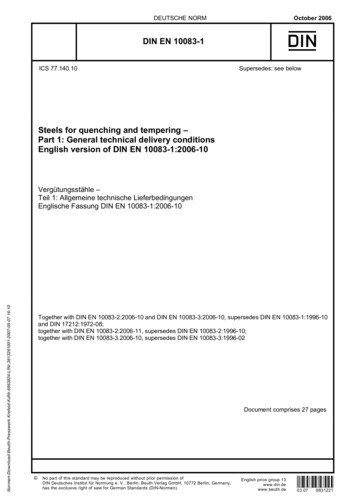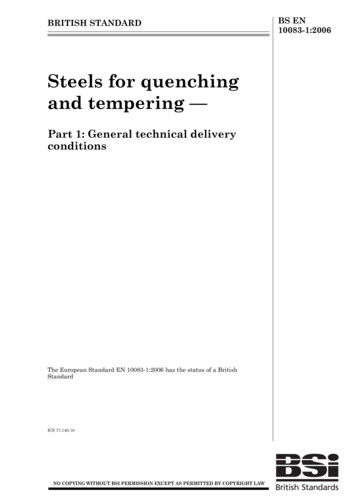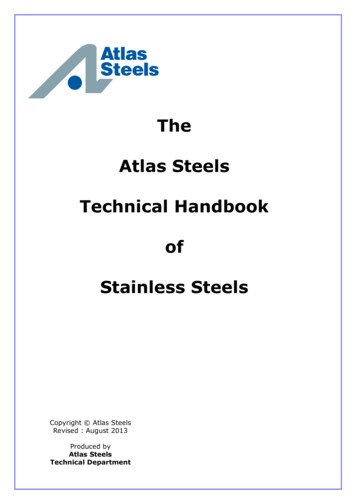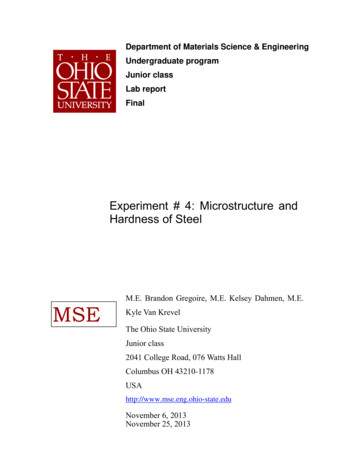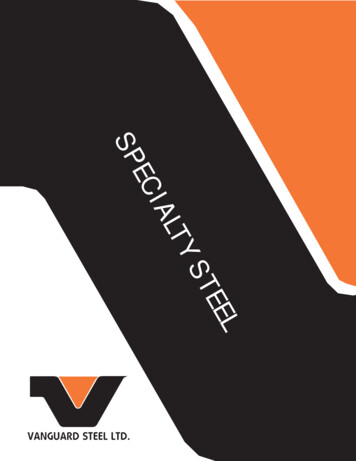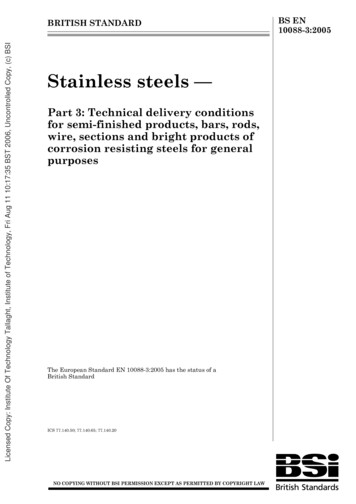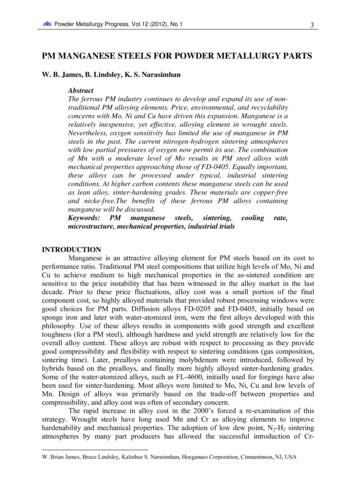
Transcription
Powder Metallurgy Progress, Vol.12 (2012), No 13PM MANGANESE STEELS FOR POWDER METALLURGY PARTSW. B. James, B. Lindsley, K. S. NarasimhanAbstractThe ferrous PM industry continues to develop and expand its use of nontraditional PM alloying elements. Price, environmental, and recyclabilityconcerns with Mo, Ni and Cu have driven this expansion. Manganese is arelatively inexpensive, yet effective, alloying element in wrought steels.Nevertheless, oxygen sensitivity has limited the use of manganese in PMsteels in the past. The current nitrogen-hydrogen sintering atmosphereswith low partial pressures of oxygen now permit its use. The combinationof Mn with a moderate level of Mo results in PM steel alloys withmechanical properties approaching those of FD-0405. Equally important,these alloys can be processed under typical, industrial sinteringconditions. At higher carbon contents these manganese steels can be usedas lean alloy, sinter-hardening grades. These materials are copper-freeand nicke-free.The benefits of these ferrous PM alloys containingmanganese will be discussed.Keywords: PM manganese steels, sintering, cooling rate,microstructure, mechanical properties, industrial trialsINTRODUCTIONManganese is an attractive alloying element for PM steels based on its cost toperformance ratio. Traditional PM steel compositions that utilize high levels of Mo, Ni andCu to achieve medium to high mechanical properties in the as-sintered condition aresensitive to the price instability that has been witnessed in the alloy market in the lastdecade. Prior to these price fluctuations, alloy cost was a small portion of the finalcomponent cost, so highly alloyed materials that provided robust processing windows weregood choices for PM parts. Diffusion alloys FD-0205 and FD-0405, initially based onsponge iron and later with water-atomized iron, were the first alloys developed with thisphilosophy. Use of these alloys results in components with good strength and excellenttoughness (for a PM steel), although hardness and yield strength are relatively low for theoverall alloy content. These alloys are robust with respect to processing as they providegood compressibility and flexibility with respect to sintering conditions (gas composition,sintering time). Later, prealloys containing molybdenum were introduced, followed byhybrids based on the prealloys, and finally more highly alloyed sinter-hardening grades.Some of the water-atomized alloys, such as FL-4600, initially used for forgings have alsobeen used for sinter-hardening. Most alloys were limited to Mo, Ni, Cu and low levels ofMn. Design of alloys was primarily based on the trade-off between properties andcompressibility, and alloy cost was often of secondary concern.The rapid increase in alloy cost in the 2000’s forced a re-examination of thisstrategy. Wrought steels have long used Mn and Cr as alloying elements to improvehardenability and mechanical properties. The adoption of low dew point, N2-H2 sinteringatmospheres by many part producers has allowed the successful introduction of CrW. Brian James, Bruce Lindsley, Kaluthur S. Narasimhan, Hoeganaes Corporation, Cinnaminson, NJ, USA
4Powder Metallurgy Progress, Vol.12 (2012), No 1containing PM steels into the marketplace. To date, PM steels with Mn contents 0.5 wt%have not gained widespread use, despite extensive research into Mn-containing alloys thathas been conducted [1-9]. Prealloying manganese in water atomized PM steel at levelsgreater than 0.5% is impractical, as oxide mitigation becomes extremely difficult andcompressibility greatly decreases. Nevertheless, manganese can be introduced by way ofadditives. Several additives have been evaluated, including medium and high carbonferromanganese [1-3,5,6], Fe-Mn-Si master alloys [7], and a specially designed Fe-Mn-Calloy [8]. Upon sintering, Mn has been found to diffuse away rapidly from additives by wayof gas vapor through the pore network in PM compacts [2]. This is followed by slowersolid-state diffusion into the matrix of the base iron. The vapor phase occurs below 1120 C,allowing Mn steels to be processed with conventional sintering. Utilizing an Fe-Mn-Cadditive, demonstration oil pump parts sintered at 1120 C were found to have propertiessimilar to that of FD-0205 [9].The current study is an extension of earlier research [10] that showed Mn steelscan be produced and sintered using conventional practices. Figures 1 and 2 show that thismaterial system has a robust sintering response, as properties only slowly decrease withlower sintering temperature and time in a similar way to diffusion alloy FD-0405. Extendedsintering times and higher temperatures were not required. The combination of Mo and Mnprovides good hardenability, thereby boosting as-sintered hardness and yield strength. Thispaper discusses the properties of Mn steels and compares them with traditional Fe-Mo-NiCu PM alloys.Fig.1.Fig.2.Figs.1. and 2. The effect of sintering time and temperature on apparent hardness (Fig.1) andTRS (Fig.2) for FD-0405 and a 1.3% Mn – 0.5% Mo alloy [from reference 10].EXPERIMENTAL PROCEDUREThe manganese-containing alloys were compared with several MPIF standardmaterial grades as listed in Table 1. A graphite addition of 0.6% was made to all thematerials except the FLNC-4408 which had a 0.9% addition. An addition of 0.75%Acrawax C lubricant was made to all of the mixes.
5Powder Metallurgy Progress, Vol.12 (2012), No 1Tab.I. Nominal composition of the base alloys studied.IDFe (wt.%)Mo l.0.8** prealloyed, ** diffusion alloyedNi (wt.%)Cu (wt.%)Mn (wt.%)--1.3--1.324**21.5**1.50.1*0.1*0.1*ANCORBOND FLM-4005 Alloy 1ANCORBOND FLM-4405 Alloy 2Standard transverse rupture strength and flat, unmachined (dogbone) tensilespecimens were pressed at 415, 550, and 690 MPa and sintered in a 90% nitrogen / 10%hydrogen atmosphere in a continuous belt furnace for 15 minutes at temperature (45minutes in the hot zone). The sintering temperature was 1120 C with two cooling ratesutilized: 0.7 C/s, or 1.6 C/s - measured between 650 C and 315 C. The samples cooledat 1.6 C/s were tempered at 200 C for 1 hour.In addition to standard mechanical testing, the hardenability of the Mn alloys wasinvestigated. This was accomplished by Jominy end-quench testing. Jominy end-quenchhardenability specimens were prepared using the technique described in reference 11. Bars100 mm long and 25 mm diameter at nominally 7.0 g/cm3 were end quenched from 900 C.The hardenability of alloy FD-0405 is derived from MPIF standard 35 data and estimatedfor a density of 7.0 g/cm3.Samples for metallographic examination were sectioned, mounted in athermosetting epoxy, and ground and polished using well-established practices. Thepolished surface of the samples was then impregnated with epoxy to ensure accuraterepresentation of the porosity and to seal off the porosity, thereby avoiding entrapment ofpolishing compound, water and etchants that can later lead to staining of the microstructure.The samples were lightly ground, re-polished and etched in a 50-50 mixture of 2% nital –4% picral.RESULTSThe Mn-containing alloys were compared with three standard MPIF alloys, FLN24405, FD-0405 and FLNC-4408. These materials were chosen as they are hybrid anddiffusion alloys that provide good mechanical properties through alloying with Mo,elemental Ni additions, and in two cases, Cu additions. The compressibility of the Mn steelsis 0.07 g/cm3 lower than the three highly compressible Mo-Ni (-Cu) alloys over a range ofcompaction pressures (Fig.3). Upon sintering, the Mn alloys behave similarly to Cu steels,in that they exhibit growth (Fig.4). The Ni-containing steels shrink relative to the Mnalloys, with the Cu-free FLN2-4405 having the lowest growth.
6Powder Metallurgy Progress, Vol.12 (2012), No 1Fig.3. Compressibility.Fig.4. Dimensional Change.The apparent hardness values for the five alloys are shown in Fig.5. FLNC-4408,containing the higher graphite content, has the highest hardness in the as-sintered condition.Alloy 2(FLM-4405), with the same Mo content but lower graphite and no Ni or Cu, has asimilar hardness. Additionally, Alloy 1 and FD-0405, having the same Mo content, havesimilar hardness. The effect of Mn on hardness is clearly evident as 1.3% Mn effectivelyreplaces 4% Ni and 1.5% Cu. The FLN2-4405 has the lowest hardness with conventionalsintering. Figure 5b contains the data generated with accelerated cooling. Alloy 2 now has ahigher hardness than FLNC-4408 at a lower carbon content. Alloy 1 (FLM-4005) exhibits asignificant increase in hardness with accelerated cooling, reaching 30 HRC at a 7.05 g/cm3.By adding 0.2% additional graphite, the hardness of Alloy 1 increases to that of Alloy 2.Alloy 1 with a total of 0.8% graphite is a lower cost alternative to reach high hardness,although the other mechanical properties, such as strength, elongation and impact, decrease10 to 20% as a result. The Mo and C contents can be tailored to meet specific componentrequirements in the most cost-effective manner. Alloy FD-0405 shows little change inapparent hardness with accelerated cooling. This can be viewed as either FD-0405 is not aneffective sinter-hardening alloy, or FD-0405 is quite stable with variations in cooling rate.The yield strength of the two Mn alloys is quite good, and both meet or exceed theyield strength of the Ni-containing alloys. It can been seen in Fig.6, that the yield strengthof Alloy 2 far exceeds that of the other alloys when accelerated cooling is used. Theultimate tensile strength of the Mn alloys is similar to the Ni-containing steels withconventional cooling and show a benefit with accelerated cooling, Fig.7. Given the highyield strengths, the total elongation of the Mn alloys and the sinter-hardened FLNC-4408 islower than for the FLN2-4405 and FD-0405 – Figure 8. Impact energy is similar for allalloys except the FD-0405, as PM diffusion alloys are known for high toughness – Fig.9.These results show the potential of the Mn alloys to deliver properties greater thantraditional PM steels with equivalent Mo content and no elemental Ni or Cu additions.
7Powder Metallurgy Progress, Vol.12 (2012), No 1a)b)Fig.5. Apparent Hardness (after tempering) (a) Conventional cooling (0.7 C/s) and (b)Accelerated cooling (1.6 C/s).a)b)Fig.6. Yield Strength (a) Conventional cooling (0.7 C/s) and (b) Accelerated cooling(1.6 C/s).The microstructures of all five alloys are presented in Figs.10 and 11 forconventional and accelerated cooling, respectively. The morphology of the Mn-containingsteels consists of martensitic and bainitic regions. The martensitic regions etch tan-colored,whereas the bainitic regions are white and gray. With conventional cooling, the higher MoAlloy 2 contains more lower bainite and martensite than Alloy 1. The ferrite-carbidespacing of Alloy 2 is also finer in the upper bainite / divorced pearlite morphology. All fivealloys have mixed microstructures that are typical of hybrid and diffusion-alloy systems.The light-etching Ni-rich regions are clearly present in the MPIF alloys. With acceleratedcooling, the amount of martensite increases with the Mn steels. The microstructures remainmixed, as limited Mn diffusion into the core of the larger base iron particles results inlocally reduced hardenability. The FLN2-4405 and FLNC-4408 also show a significantincrease in martensite content with accelerated cooling. Little change in microstructure wasobserved for the FD-0405. The microstructures correlate well with the observed mechanical
8Powder Metallurgy Progress, Vol.12 (2012), No 1properties. The high martensite content in the Mn-containing steels results in high apparenthardness and yield strength.a)b)Fig.7. Ultimate Tensile Strength (a) Conventional cooling (0.7 C/s) and (b) Acceleratedcooling (1.6 C/s).Fig.8. Total Elongation.Fig.9. Impact Energy.In a separate study, the effect of high temperature sintering (HTS) was evaluatedover a range of carbon contents and cooling rates for Alloys 1 and 2 at a nominal density of7.1 g/cm3. The results for Alloy 2 are shown in Figures 12-15, and similar effects werefound with Alloy 1. With conventional cooling (red data points), little change in strengthwas found with HTS. The drop in apparent hardness may be due to some carbon loss athigh temperature. Ductility and impact resistance noticeably improved. With acceleratedcooling, HTS made a significant difference in mechanical properties. While apparenthardness was unaffected, a 20% increase in strength (TRS, ultimate tensile strength) wasfound at select graphite additions. The high temperature sintering appeared to show thegreatest improvement with higher graphite additions. Maximum yield strengths of 900 MPaand 1000 MPa were found for Alloys 1 and 2, respectively, under these conditions.Additionally, ultimate tensile strengths of 1000 MPa and 1175 MPa were obtained for
Powder Metallurgy Progress, Vol.12 (2012), No 19Alloys 1 and 2, respectively, at the optimum carbon contents. These results are quiteimpressive considering the alloys contain moderate levels of Mo, with no additions of Ni orCu.Fig.10. Microstructures of the five materials after conventional cooling (0.7 C/s).
Powder Metallurgy Progress, Vol.12 (2012), No 110Fig.11. Microstructures of the five materials after accelerated cooling (1.6 C/s).The results indicate that carbon content and processing conditions should beoptimized for the specific properties required. The relationship between carbon content,cooling rate and apparent hardness is straightforward, as seen in Fig.12. Additional graphite(0.1% to 0.2%) can be added to Alloy 1 (0.5% Mo, 1.3%Mn) to obtain the same apparenthardness as Alloy 2. This did not hold true for the other properties, as optimum strengthlevels were found between 0.5% and 0.7% graphite additions for both alloys. Given theseresults, it is recommended that Alloy 1 be used for smaller components where fastercooling rates can be obtained, whereas the improved hardenability of Alloy 2 allows it to beused in slightly larger parts. This assumes that maximum properties are needed. Alloy 1 canalso be used in larger parts where the property requirements are less demanding.
Powder Metallurgy Progress, Vol.12 (2012), No 111Fig.12. The effect of carbon content,sintering temperature, and cooling rate onthe apparent hardness.Fig.13. The effect of carbon content,sintering temperature, and cooling rate onthe yield strength.Fig.14. The effect of carbon content,sintering temperature, and cooling rate onthe UTS.Fig.15. The effect of carbon content,sintering temperature, and cooling rate onthe yield strength.The presence of Mn and Mo increases alloy hardenability greatly in both wroughtand PM steels. Given that both are present in Alloys 1 and 2, these Mo-Mn alloys shouldhave good hardenability. Evidence of this was observed in the mechanical properties andmicrostructures. To quantify the hardenability of the Mn-Mo alloys, Jominy end-quenchtests were performed. Figure 16 shows the results, where a greater distance from thequenched end (J65 depth) indicates greater hardenability. The iron-based diffusion alloy haspoor hardenability, as evidenced by the short J65 depth. Alloy 1 and FLN2-4405 exhibitbetter hardenability than the more highly alloyed FD-0405, with J65 depths of 16 and 14mm respectively. A significant improvement in hardenability was found with FLNC-4408,as an increase in graphite content and the addition of Cu boosted hardenability above that ofthe related alloy FLN2-4405 from a J65 depth of 14 mm to 33 mm. Alloy 2 has the highest
Powder Metallurgy Progress, Vol.12 (2012), No 112hardenability of the alloys studied, with a depth of 38 mm. The addition of 1.3% Mn to a0.8% Mo base is clearly superior to an addition of 2% Ni and 1.5% Cu, with respect tohardenability. The hardenability of these Mn alloys allows a predominantly martensiticmicrostructure to be produced at intermediate carbon contents and with accelerated cooling.These lean alloy systems do not, however, provide the hardenability of traditional sinterhardening steels, where J65 depths of 90 mm and greater have been reported, and as such,should not be used when uniformly martensitic microstructures are required.Fig.16. Jominy end-quench hardenability for the five alloys at a 7.0 g/cm3 density. J65represents the distance from the water quenched end of the Jominy bar where the apparenthardness fell to 65 HRA.CONCLUSIONS1. Mn-containing alloys have been developed that provide good sinterability underconventional sintering conditions. High temperatures are not required, although thecombination of high temperature sintering and accelerated cooling results in very goodproperties for a lean-alloy system.2. Nitrogen-hydrogen atmospheres with low dew points and low oxygen contents arerequired with these alloys. Endothermic gas should not be used due to oxidation of themanganese.3. The mechanical properties of the Mn-Mo steels met or exceed that of several Mo-NiCu PM steels. Strength and hardness were higher than for FD-0405, FLN2-4405 andFLNC-4408. Ductility and impact resistance was similar to that of FLNC-4408.4. These lean alloys are appropriate for sinter hardening of small to medium sized parts.INDUSTRIAL TRIALSSeveral industrial trials were conducted to ensure that the new alloys are robustunder commercial processing conditions.
13Powder Metallurgy Progress, Vol.12 (2012), No 1In one trial a sprocket was made from the ANCORBOND FLM-4008 that had anaddition of 0.8% graphite. The sprockets were compacted to 7.0 g/cm3 and sintered at1120 C in a 90:10 (nitrogen:hydrogen) atmosphere and accelerated cooling was used. Thesprockets had an apparent hardness after tempering of 69 HRA (39 HRC). The sprocket andthe microstructure obtained are shown in Fig.17.a)b)Fig.17. Sprocket (a) and etched microstructure (b).For the second trial a mechanical diode was made to a sintered density of 6.8g/cm3. An apparent hardness of 30 HRC was achieved on the part surface. A similar partand the microstructure obtained are shown in Fig.18. The part met all the requirements forthe application including the tight dimensional tolerances specified.Fig.18. Mechanical diode and its microstructure.A third industrial trial was conducted to see whether the manganese steels could beinduction hardened [12]. The part selected for the trial was the sprocket shown in Fig.19.
Powder Metallurgy Progress, Vol.12 (2012), No 114Fig.19. PM sprocket.In the trial, the two PM manganese steels,ANCORBONDFLM-4005, andANCORBOND FLM-4405 were compared with the material currently used to make theinduction hardened sprocket, FLN2-4405. The microstructures of the as-sintered hubsection of the sprocket for all three materials are illustrated in Fig.20.Fig.20. Microstructures of the hub section of the PM sprocket for the three materialstested.The teeth of the as-sintered sprockets were induction hardened by heating for 3 son a 60 kW, 450 kHz induction unit followed by quenching in oil at 60 C. The parts werethen tempered at 200 C for 1 h.The induction-hardened sprocket teeth are shown in Fig.21 and an unetched viewof the surface of the teeth is presented in Fig.22 and it can be seen that there is no indication
Powder Metallurgy Progress, Vol.12 (2012), No 115of preferential oxidation of the sprocket made from the PM manganese steel compared withthe sprocket made from FLN2-4405.The desired microstructure was obtained in the induction-hardened sprockets andthe sprockets made from the manganese steel matched the performance of the sprocketsmade from FLN2-4405.Fig.21. Etched microstructure of the induction hardened sprocket teeth for all threematerials.
Powder Metallurgy Progress, Vol.12 (2012), No 116Fig.22. Oxide thickness on the surface of the induction–hardened sprocket teeth FLN24405 and (b) FLM-4005.References[1] Šalak, A.: Powder Metallurgy, 1981, no. 2, p. 64[2] Šalak, A.: International Journal of Powder Metallurgy, vol. 16, 1980, no. 4, p. 369[3] Tengzelius, J., Grek, SE., Blande, CA. In: Modern Developments in PowderMetallurgy. Vol. 13. Eds. H. Hausner, H. Antes, G. Smith. Princeton : MPIF, 1980 p.159[4] Banerjee, S., Schlieper, G., Thummler, F., Zapf, G. In: Modern Developments inPowder Metallurgy. Vol. 13. Eds. H. Hausner, H. Antes, G. Smith. Princeton : MetalPowder Industries Federation, 1980 p. 143[5] James, WB., Causton, RJ. In: Advances in Powder Metallurgy & Particulate Materials.Vol. 5. Princeton : MPIF, 1992, p. 65[6] Dudrová, E., Kabatová, M., Bidulsky, R., Wronski, AS.: Powder Metallurgy, vol. 47,2004, no. 2, p. 181[7] Zhang, Z., Frisk, K., Salwen, A., Sandstrom, R.: Powder Metallurgy, vol. 47, 2004, no.3, p. 239[8] Sainz, S., Martinez, V., Dougan, M., Baumgaertner, F., Castro, F. In: Advances inPowder Metallurgy & Particulate Materials. Princeton : Metal Powder IndustriesFederation, 2006, part 7, p. 95[9] Dougan, MJ., Morato, J. In: Advances in Powder Metallurgy & Particulate Materials.Princeton : Metal Powder Industries Federation, 2008, part 7, p. 35[10] Lindsley, B. In: Advances in Powder Metallurgy & Particulate Materials. Princeton :MPIF, 2008, part 7, p. 17[11] Sokolowski, PK., Lindsley, BA. In: Advances in Powder Metallurgy & ParticulateMaterials. Princeton : MPIF, 2009, part 7, p. 1[12] Lindsley, B., Shah, S., Schluterman, G., Falleur, J. In: Advances in Powder Metallurgy& Particulate Materials. Princeton : MPIF, 2011, part 9, p. 103
4% picral. RESULTS The Mn-containing alloys were compared with three standard MPIF alloys, FLN2-4405, FD-0405 and FLNC-4408. These materials were chosen as they are hybrid and diffusion alloys that provide good mechanical properties through alloying with Mo, elemental Ni additions, and in t
